Drones Make Their Mark in Hurricane Coverage
OTTAWA—From a news standpoint, the past two months will be remembered for two things: The trio of hurricanes that devastated the southeastern U.S. and the Caribbean, and the rise of news drones as a vital form of visual storytelling.
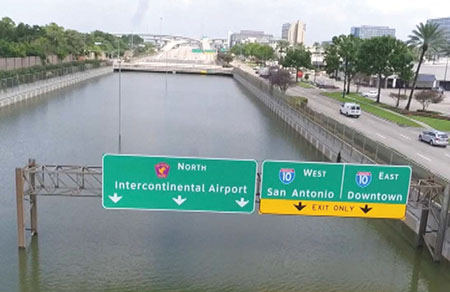
Fox News was able to get footage after Hurricane Harvey hit Houston that it never would have been able to get from helicopters, according to Ben Ramos, vice president of field operations.
“Drones provide that vantage point that completely changes a story,” said Maria Stefanopoulos, production manager at ABC News/Good Morning America, referring to the network’s hurricane coverage. “Some of the most striking images were the ones that showed before-and-after shots of neighborhoods completely submerged under water. And when the water receded, the aerials of the aftermath and debris lining the sidewalks and streets were jaw-dropping.”
For Greg Agvent, senior director of CNN Air (the news channel’s drone division), drone footage provided viewers with a heightened “context, perspective, and understanding” of Harvey/Irma/Maria’s appalling damage and human cost.
Before the news channel started using drones, “there was this great nothingness between ground level and 1,500 feet with a helicopter,” Agvent said. “The drone helps to fill that void to provide really intimate imagery. You can still get a sense of the damage from higher up, but a low-altitude drone shot is just much more intimate and emotional than the straight helicopter shot.”
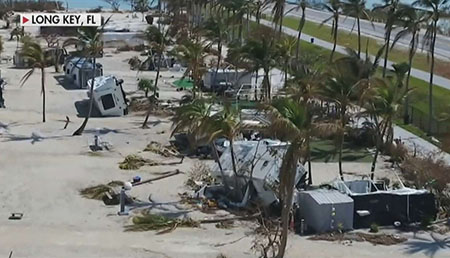
Fox News drone coverage after Hurricane Irma devastated the Florida Keys.
One CNN drone shot that provided such context occurred in Puerto Rico after Hurricane Maria, when a reporter was covering the plight of a Vietnam veteran and his power-less hillside home. The video started using a ground shot of the house beside a downed powerline and collapsed steel tower.
Get the TV Tech Newsletter
The professional video industry's #1 source for news, trends and product and tech information. Sign up below.
CNN then cut live to a rising drone’s camera view: “As the drone continued to pull out on the reporter on the ground, you saw not only that individual steel tower but the succession of steel towers,” said Agvent; “and the lines down, and the impact of it, and the devastation all around.”
Of course, news drones can’t legally fly at high altitudes and bad weather, while helicopters can. But drones make up for this shortfall by getting great shots when the skies eventually clear.
“While flying in Texas was more difficult than we anticipated, we did get some the devastating flooding visuals to our viewers that we never would have previously achieved with traditional helicopters,” said Ben Ramos, vice president of field operations for Fox News. “After Irma, our drone aerials clearly showed the nightmare Florida residents are still enduring. While helicopter aerials tell a story, drones bring the viewer even closer to the tragedy that was Irma.”
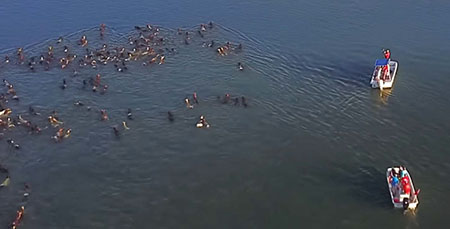
WBOC-TV used its SkyCam16 Drone to cover the annual Chincoteague Pony Swim at Assateague Island in the Delmarva Peninsula in July.
THE ASCENDENCY OF NEWS DRONES
Even before the recent hurricane trifecta, U.S. TV networks and stations have been increasingly turning to drones to capture eye-catching news footage. This is why “drones in general are rapidly becoming essential tools for TV and digital news outlets,” said Dan Shelly, executive director of the Radio Television Digital News Association (RTNDA). “Drones are a cost-effective way to examine the subject matter of news stories from the air.”
A case in point: When a bridge on Georgia’s I-85 caught fire and then collapsed on March 30, 2017, FOX 5 Atlanta (WAGA-TV) dispatched their news helicopter to cover the scene live. The next day, the station’s SkyFOX 5 Drone took over, and became FOX 5’s eye in the sky as the repairs continued for the long-term.
The same strategy was followed by Atlanta’s other TV stations. As a result, “the first day of the bridge collapse belonged to the news helicopters,” said WAGA-TV Chief Pilot/Reporter/Anchor Doug Evans. “From then on out for the next 45 days, the story belonged to the drones.”
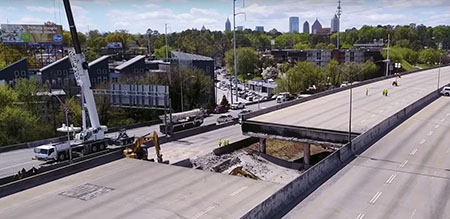
FOX 5 Atlanta used its SkyFOX 5 Drone as its “eye in the sky” after the collapse of a bridge on Georgia’s I-85 in March.
Sometimes the news being covered is not tragic but equally eye-catching, such as the annual Chincoteague Pony Swim at Assateague Island. Located off the Delmarva Peninsula (shared by Maryland and Virginia) in the Atlantic Ocean, Assateague Island is home to two herds of so-called “Chincoteague Ponies.” Every year, during a summer slack tide when there’s no ocean current, about 200 of these ponies swim (under human direction) to the mainland for health checks.
CBS-affiliate WBOC-TV’s SkyCam16 Drone covered this summer’s event from above. “We got some astounding shots of the ponies swimming across the channel, including panoramas and stationary hovers that told the story incredibly well,” said Bill Mich, drone pilot (one of six), video journalist and weekend anchor for the Salisbury, Md.-based station. “You couldn’t get a shot like this from a helicopter, because it would spook the horses if it got too close,” added WBOC News Director John Dearing.
Drone Lessons Learned
In the relatively short time that broadcasters have been able to fly news drones, some valuable lessons have been learned:
Lesson #1: Be prepared. In the case of natural disasters, drone crews need to have sufficient battery power, recharging capability, and independent communications to keep their aircraft flying and connected. “When a hurricane strikes, it’s usually followed by power outages and minimal resources available after the storm passes,” said Stefanopoulos. “Drones are privy to the same problems that other forms of technology face. If you can’t power your cell phone, you can’t charge your drone batteries!”
Lesson #2: Speak up! When it comes to flying news drones safely, “you simply cannot over-communicate your intentions to the folks in the area you intend to operate in,” said Greg Agvent, senior director of CNN Air. “That’s extremely important.”
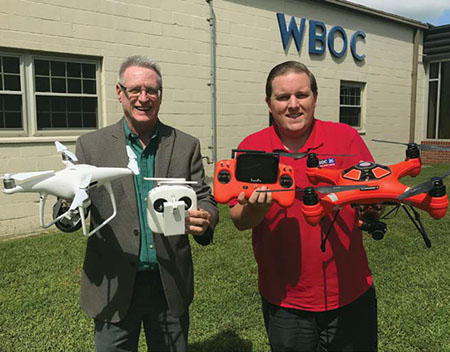
John Dearing, news director and Drone Pilot Bill Mich with WBOC-TV
Lesson #3: Work with first responders, not against them. For FOX 5, a constructive relationship with the Atlanta Fire Rescue Department was key to winning permission to shoot the I-85 bridge repair operation up close. “We were able to safely hover the drone right over the opening where the bridge collapsed,” said WAGA-TV Chief Pilot/Reporter/Anchor Doug Evans. “This happened because we got permission to do so from an AFRD battalion chief at the scene.”
Lesson #4: Earn and promote a reputation for adhering strictly to FAA Part 107 rules, because it can pay off during crises. “During our coverage of Hurricane Harvey, we were about to put a drone up to get some aerials of the flooding, and an enormous Temporary Flight Restriction was put into place so we couldn’t fly,” said Chris O’Regan, senior manager of ABC News’ Logistics Desk. “But our pilot was able to put in a request for permission to fly within the TFR, which the FAA approved so we were able to fly the drone inside the TFR.”
Lesson #5: “Always have drones serviced, charged, and available for flight,” said Evans. To never miss a story that can benefit from drone footage, “we always have a drone-trained news crew in the field equipped with a drone, just in case.”
Lesson #6:“Don’t expect news drones to replace news helicopters,” said WBOC News Director John Dearing. “Each operate at different altitudes under different rules. For complete aerial coverage, you need both.”
Lesson #7: When lives are at stake in disasters like Hurricanes Harvey and Irma, remember that “there are more important things than drone aerial pictures,” said Ben Ramos, vice president of field operations for Fox News. “As thousands of rescue helicopter flights were launching and saving lives, you quickly realize something a bit counter-intuitive in the competitive TV news business: You find yourself not frustrated by rain and TFRs and lack of aerial pictures, but oddly you find yourself saying ‘I’m glad we aren’t allowed to fly today, this is way more important!’”
James Careless
BENEFITS AND CHALLENGES
Drones fill the gap between ground level camera shots and overhead high-elevation helicopter shots, while at the same time, using a drone is cheaper than commissioning a helicopter, according to Stefanopoulos.
“In the right circumstance, a drone can be used at a moment’s notice, bringing what was once a rare form of videography to the mainstream,” she said.
For CNN, saving money on helicopters was never a motivation, since the news channel has never owned any aircraft. Instead, it is the drone’s ability to shoot engaging visuals to dress up talking-head events like the 2016 Republican National Convention; enhance story-telling on the U.S./Mexico border for a week-long series about President Trump’s proposed wall; and provide amazing aerial shots during breaking news events like this season’s hurricanes that has made the technology worth investing in.
On the flip side, flying news drones is challenging in many ways. To comply with FAA regulations and to ensure that their drone pilots consistently fly in a safe manner, the broadcasters TV Technology interviewed for this story insist on exacting multiday training for staff operators. This requires a serious and ongoing investment of time and money. (To fly CNN’s mix of drones, the news channel has hired two licensed private pilots. This is a level of piloting skill that exceeds FAA drone requirements, but is worth it to put “safety first,” said Agvent.)
Also, the FAA’s Part 107 drone-flying rules are quite limiting. To comply with them, drones cannot fly over people or be deployed from a moving vehicle. They also have to stay below 400 feet, be within sight of the pilot and/or their “visual spotter,” fly during the day, and yield to manned aircraft. Add the requirement not to interfere with first responders, and drones can’t necessarily be set aloft anytime a four-alarm fire breaks out.
Beyond these regulatory restrictions, weather is always a concern. “We were limited when flying drones to cover Hurricanes Harvey and Irma until the storms were well past,” said Fox News’ Ramos. “The winds were too strong and the rain too heavy to fly where we wanted to fly.”
One unexpected limit is that drones can unexpectedly “decide” to land, due to low battery power or signal loss. If the drone is over water, it can be lost.
This is why WBOC-TV has invested in a waterproof Splash Drone III. “The camera is so immersible, that we were able to take off with the camera underwater in a lake, before rising the Splash III into the sky,” said Mich. “Not only did the video look amazing, but we knew we had a drone that floats when it hits water; rather than sinking.”
James Careless is an award-winning journalist who has written for TV Technology since the 1990s. He has covered HDTV from the days of the six competing HDTV formats that led to the 1993 Grand Alliance, and onwards through ATSC 3.0 and OTT. He also writes for Radio World, along with other publications in aerospace, defense, public safety, streaming media, plus the amusement park industry for something different.

